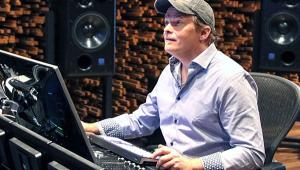Beautiful Music
 Organized chaos. That's what I witness as I walk backstage and move through the adjoining corridors of the Staples Center. It's the day before the Grammy telecast, the final of three rehearsal days leading up to the big event. U2 has just finished their hour-and-a-half rehearsal, and breaking down their set has taken longer than planned. While one team maneuvers U2's massive equipment through the ramps backstage, another works feverishly to ready the stage for the next act. Still other crew members hurry to and fro with no apparent destination.
Organized chaos. That's what I witness as I walk backstage and move through the adjoining corridors of the Staples Center. It's the day before the Grammy telecast, the final of three rehearsal days leading up to the big event. U2 has just finished their hour-and-a-half rehearsal, and breaking down their set has taken longer than planned. While one team maneuvers U2's massive equipment through the ramps backstage, another works feverishly to ready the stage for the next act. Still other crew members hurry to and fro with no apparent destination.
Appearances can be deceiving, though. "Everyone here has a singular purpose," explains Michael Abbott, the project coordinator in charge of making every aspect of the elaborate Grammy stage show come together. Whether it's making sure one wire is connected or one stage mark is hit, each crew member executing his or her singular task is what allows a complicated production like this to appear seamless.
Away from the chaos of the inner circle, director Walter Miller and the show's many technical engineers monitor the onstage goings-on from the production trucks. Like the stage crew, each engineer has a specific task, a visual or audio mark that they must hit to create an outstanding broadcast. Their goal isn't just to cover this live show; rather, it's to create a musical event worthy of the artists and industry it honors.

The anchor of the HDTV telecast is the trio of Sony HD cameras that sit in the center of the arena. [Photo credit: Courtesy of the Recording Academy, Photograph by John Shearer/WireImage (c) 2006]
Dedicated to Surround
It should come as no surprise that, for the Grammy telecast, music is key. As one crew member explains, "It's our job to make sure that what this show provides to the viewers is as close as possible to what the artists intend." So it's also no surprise that the National Academy of Recording Arts and Sciences (or NARAS) has embraced HDTV, especially the Dolby Digital 5.1 surround mix.

5.1 mixer Paul Sandweiss monitors the onstage action with JBL speakers and an assortment of LCD panels. He performs his 5.1 magic with a Yamaha DM2000 mixing console. [Photo credit: Courtesy of the Recording Academy, Photograph by John Shearer/WireImage (c) 2006]
Since the show first aired in HD in 2003, NARAS has used a dedicated surround mixer whose sole job is to integrate the various sources, including live music, dialogue, video playback, and audience response, into an effective 5.1 mix. For the past few years, that man has been Paul Sandweiss. Today, as rehearsals press on, he's mostly getting a feel for how each act will progress. The real work begins when the show goes live and he receives the needed elements to create his mix.
Paul has worked on 5.1 mixes for many concert DVDs, but the Grammy experience is unique. "This is the only show I know of that actually has a stereo mixer and a 5.1 mixer. Most shows do 5.1 and create a stereo mix from it, or vice versa. I think [having both consoles] is well worth it. They're two separate entities and need to be tended do differently." One of the challenges of this 5.1 mix is that the audio, video, and ambience need to be much more synchronized than, say, that of a football broadcast. "A sporting event is an event that happens," Paul says. "You show up, and you cover it. This is an event we create, and then we cover it. The show is controlled by the production element."

Kicking off a night of interesting duets, Mary J. Blige joined U2 for a stirring rendition of the band's hit "One." [Photo credit: Courtesy of the Recording Academy, Photograph by Lester Cohen/WireImage (c) 2006]
As the lingering sounds of U2's "Vertigo" echo throughout his small truck, Paul discusses the value of his craft. "Well-done 5.1 sound can put you in the venue [so you get] the energy that's happening in the room." With each passing year, he's learned to have more fun with the mix. "Moving from two channels to 5.1 is like painting with charcoal and then getting a color set. It's a whole new world. At first, you probably stay close to the charcoal, but pretty soon you're like, 'Give me some of that red!'"
Ever-Evolving Audio
Of course, the sum of Paul's mix can only be as good as its parts. With each passing year, the production has evolved to help Paul render the best multichannel soundtrack. A couple of years ago, that meant adding a dedicated audience mixer. In another small trailer, I meet Klaus Landsberg, whose only job is to scan the audience for the best "pockets of energy" during the show. Right now, he's simply balancing the audio levels in the 46 microphones placed around the arena; but, the night of the show, he must make quick, on-the-fly choices to find the best, most natural information for the 5.1 and stereo mixes.

In the primary mixing truck, sound mixer Eric Schilling watches and records Christina Aguilera and Herbie Hancock's rehearsal. Later, he can take that recording to an identical truck next door to practice the mix.
Perhaps no job is more important to the show's audio quality than that of the sound mixers, who decide what the TV audience hears in each performance. These pre-show rehearsals are crucial for sound mixers John Harris and Eric Schilling—it's their chance to listen to and record the artists in order to study the performances and practice the mix. When to showcase The Edge's guitar, how much energy to give to the gospel choir accompanying Mariah Carey, keeping track of the lead vocals during the crowded tribute to Sly Stone-these are all the responsibility of the sound mixers.
In years past, both mixers, who handle alternating performances, worked out of a single truck. Each man had only about one hour between rehearsals to listen to the recording and practice the mix. This year, NARAS added a second truck, so, while one man sets up and records an act in the primary truck, the other can be practicing his mixes in the second truck, working with identical equipment. This gives them more time to acquaint themselves with the songs and prepare the best-sounding mixes possible.
The Show Must Go On
Technology and thoughtful planning can certainly enhance a production, but ultimately it's the passion of the people behind the scenes, some of whom have worked on the Grammy telecast for over 20 years, that elevates this broadcast to a higher level. It takes a true music lover to artfully create a sound mix, a true concert fan to mindfully blend elements to create a natural surround mix. In the end, passion and technology combined to produce a Grammy show that, while not entirely seamless, featured excellently rendered mixes of some inspired performances by Bruce Springsteen, Paul McCartney, U2, and Kanye West, just to name a few.
Tech Notes
On the audio side:
• Equipment in the production trucks include Yamaha DM2000 mixing consoles, Dolby encoding and monitoring equipment, JBL speakers, and Pro Tools hardware and software.
• Landsberg's audience microphones were supplied by Sennheiser and AKG; he used PreSonus DigiMAX microphone preamps; the audio comes in analog and is converted to S/PDIF digital.
• This year, the sound-effects editor used new software, called SpotOn, to cue up sound effects, such as the songs nominated in each category. This year's sound effects were in stereo, but the new software has 5.1 playback ability, and several DualDiscs were used. He believes it's only a matter of time until the sound cues are in multichannel, as well.
• Wireless microphones are the performers' microphone of choice. A high-end RF antenna system is in place around the stage, and one man is responsible for assigning microphones, making sure that no two frequencies interact with each other, and preventing the use of unauthorized frequencies around the arena.
On the video side:
• A total of 17 HD cameras were used, including stationary Sony HD cameras with Canon telephoto lenses and multiple floating cameras around the stage and throughout the audience.
• Video operators monitor all of the HD video coming from the cameramen; they control shading, exposure, and aperture to make sure the video from each camera looks the same so that, when the director switches from one shot to another, the overall look of the show remains consistent.
• All of the prerecorded footage and any instant replays you see during the telecast come from digital video recorders; tape is no longer used.
• Four Lightning 28sx DLP projectors from Digital Projection International rendered the images on the large video screens in the arena.





























































